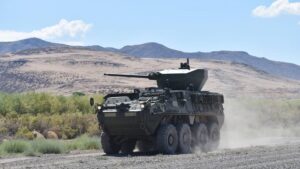Oshkosh Defense [OSK] is citing its innovation experience in the tactical wheeled vehicle (TWV) space as a key factor in meeting the Army’s iterative design process for the Optionally Manned Fighting Vehicle competition, a company official told Defense Daily
while outlining the firm’s approach to the Bradley replacement program.
Pat Williams, Oshkosh Defense’s vice president of U.S. Army and Marine Corps programs, said he sees the company’s recent win of the Army’s Stryker Medium Caliber Weapon System (MCWS) contract as an opportunity to establish itself as a “credible competitor” in the combat vehicle realm.

“We innovate and we do a lot of great things with the design and requirements and innovation in the tactical wheeled vehicle space, but we’ve not really made forays into combat vehicles as such. You could argue that the M-ATV or JLTV blurs the lines between tactical wheeled vehicles and combat vehicles, but Stryker [MCWS] was really our first foray into working in the combat vehicle space. I think what that brings with us, and along with our partnerships, is a certain amount of credibility. You go from being an outsider to being seen as a more credible competitor,” Williams said during an interview at last week’s Association of the United States Army conference.
In July, the Army awarded nearly $300 million in contracts to Oshkosh Defense, General Dynamics Land Systems [GD], BAE Systems, Rheinmetall and armor supplier Point Blank Enterprises to work on refining their OMFV concepts over the next 15 months (Defense Daily, July 23).
“We have a different perspective from the standard competitors in this space. They’re very talented and very capable folks. We just come from a different perspective in terms of being a not-standard combat vehicle offeror. So we bring an approach to innovation, flexibility and listening to the customer’s evolving requirements. That’s not to say that the other competitors don’t, but we come from a different angle on it,” Williams said.
Oshkosh Defense has partnered with South Korea’s Hanwha to leverage its Redback chassis for its OMFV concept, with its team also including the company’s Pratt & Miller subsidiary, Israel’s Rafael for the turret design, Plasan for armor contributions and QinetiQ’s autonomy and robotics experience.
“Where we settled with our approach was that we deemed it best, based on the program timelines for development and deliverables under this concept, that it was best to have a team of industry experts bringing with them a certain amount of technical maturity in the designs and the flexibility to move and shift as the requirements evolve,” Williams said. “That’s what really led us to the team we picked. It’s people who are a lot like us. We’re innovators.”
Following on its extensive experience delivering TWV platforms such as the Joint Light Tactical Vehicles and Family of Medium Tactical Vehicle trucks, Oshkosh Defense was awarded a potential $942 million deal in June to produce the new 30mm MCWS for the Army’s Stryker vehicles (Defense Daily, June 3).
“The opportunity under the Stryker lethality program to mature it with the XM813 cannon in it certainly helps. But the turret size, requirements and scope for Stryker lethality is night and day different from that for the OMFV turret. So while it helps, we can’t just take this turret off and slap it on an OMFV and there we are. It’s more so about the process with Rafael of working through the design to meet the requirements for Stryker and it’s built up muscle memory for how we’re approaching OMFV,” Williams said.
The Army last month completed initial concept reviews with the OMFV competitors, and Williams said he expects a refined set of requirements in November based on assessment of the concepts with a second review set for January (Defense Daily, Oct. 12).
“There are some big design decisions that will drive the size, weight and dimensions of your vehicle. They’ve been asking all of the different participants what are the key elements and things we need to know in this phase of the concept design to follow on. So I think we’ll see some definition on those things. I don’t think we’ll see down to a specific dimension for the tie-down bracket or something like that, it won’t be that detailed. But for the big foundational requirements that drive a lot of the base of the design, I think we’ll see that,” Williams said.